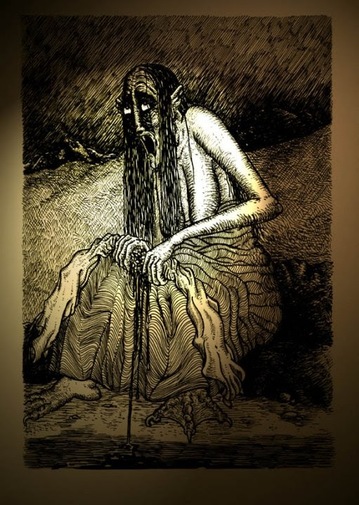And before you can say "damn, there goes more talk about Vlad Tepes", no, I'm not talking about our favorite impaler. In fact, as I learned today, there is no official register in Bram Stoker's writings that he even knew Vlad was an impaler - he knew some things about Romenian history and Vlad, but didn't mention in his writings that this historical figure was his inspiration for Bela Lugosi's alter ego.
Historians now claim that Stoker might have based his vampire in a Irish floklore character, the Abhartach. Also referred to as Avartagh (Irish word for dwarf), he is part of an early Irish legend, which was first collected in Patrick Weston Joyce's The Origin and History of Irish Names of Places (1875). Check out the legend below:
"There is a place in the parish of Errigal in Derry, called Slaghtaverty, but it ought to have been called Laghtaverty, the laght or sepulchral monument of the abhartach [avartagh] or dwarf (see p. 61, supra). This dwarf was a magician, and a dreadful tyrant, and after having perpetrated great cruelties on the people he was at last vanquished and slain by a neighbouring chieftain; some say by Fionn Mac Cumhail. He was buried in a standing posture, but the very next day he appeared in his old haunts, more cruel and vigorous than ever. And the chief slew him a second time and buried him as before, but again he escaped from the grave, and spread terror through the whole country. The chief then consulted a druid, and according to his directions, he slew the dwarf a third time, and buried him in the same place, with his head downwards; which subdued his magical power, so that he never again appeared on earth. The laght raised over the dwarf is still there, and you may hear the legend with much detail from the natives of the place, one of whom told it to me."
In some versions Abhartach rises from his grave to drink the blood of his subjects, while the chieftain who slays the revenant is named as Cathrain. The hero variously consults an early Christian saint instead of a druid, and is told that Abhartach is one of the "neamh-mairbh", or walking dead, and that he can only be restrained by killing him with a sword made of yew wood, burying him upside down, surrounding his grave with thorns, and placing a large stone on top of the grave. I bet Van Helsing didn't have that much of trouble!
According to recent folklore, Abhartach's grave is now known as Slaghtaverty Dolmen, and is locally referred to as "The Giant’s Grave". It comprises a large rock and two smaller rocks under a hawthorn.
Historians now claim that Stoker might have based his vampire in a Irish floklore character, the Abhartach. Also referred to as Avartagh (Irish word for dwarf), he is part of an early Irish legend, which was first collected in Patrick Weston Joyce's The Origin and History of Irish Names of Places (1875). Check out the legend below:
"There is a place in the parish of Errigal in Derry, called Slaghtaverty, but it ought to have been called Laghtaverty, the laght or sepulchral monument of the abhartach [avartagh] or dwarf (see p. 61, supra). This dwarf was a magician, and a dreadful tyrant, and after having perpetrated great cruelties on the people he was at last vanquished and slain by a neighbouring chieftain; some say by Fionn Mac Cumhail. He was buried in a standing posture, but the very next day he appeared in his old haunts, more cruel and vigorous than ever. And the chief slew him a second time and buried him as before, but again he escaped from the grave, and spread terror through the whole country. The chief then consulted a druid, and according to his directions, he slew the dwarf a third time, and buried him in the same place, with his head downwards; which subdued his magical power, so that he never again appeared on earth. The laght raised over the dwarf is still there, and you may hear the legend with much detail from the natives of the place, one of whom told it to me."
In some versions Abhartach rises from his grave to drink the blood of his subjects, while the chieftain who slays the revenant is named as Cathrain. The hero variously consults an early Christian saint instead of a druid, and is told that Abhartach is one of the "neamh-mairbh", or walking dead, and that he can only be restrained by killing him with a sword made of yew wood, burying him upside down, surrounding his grave with thorns, and placing a large stone on top of the grave. I bet Van Helsing didn't have that much of trouble!
According to recent folklore, Abhartach's grave is now known as Slaghtaverty Dolmen, and is locally referred to as "The Giant’s Grave". It comprises a large rock and two smaller rocks under a hawthorn.
~Ally

 RSS Feed
RSS Feed